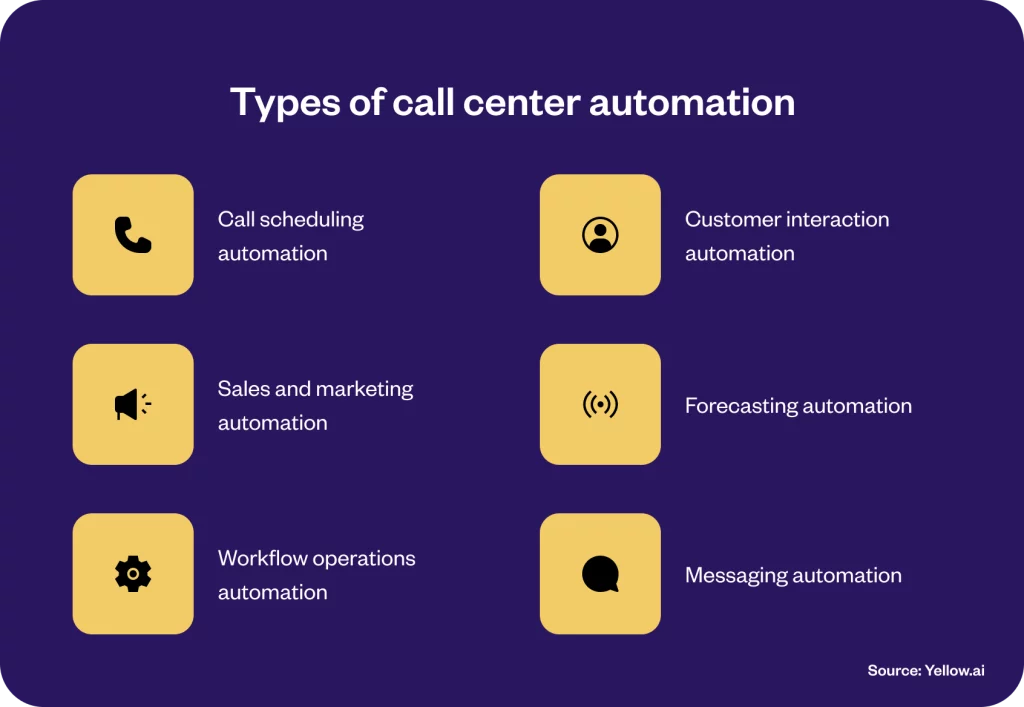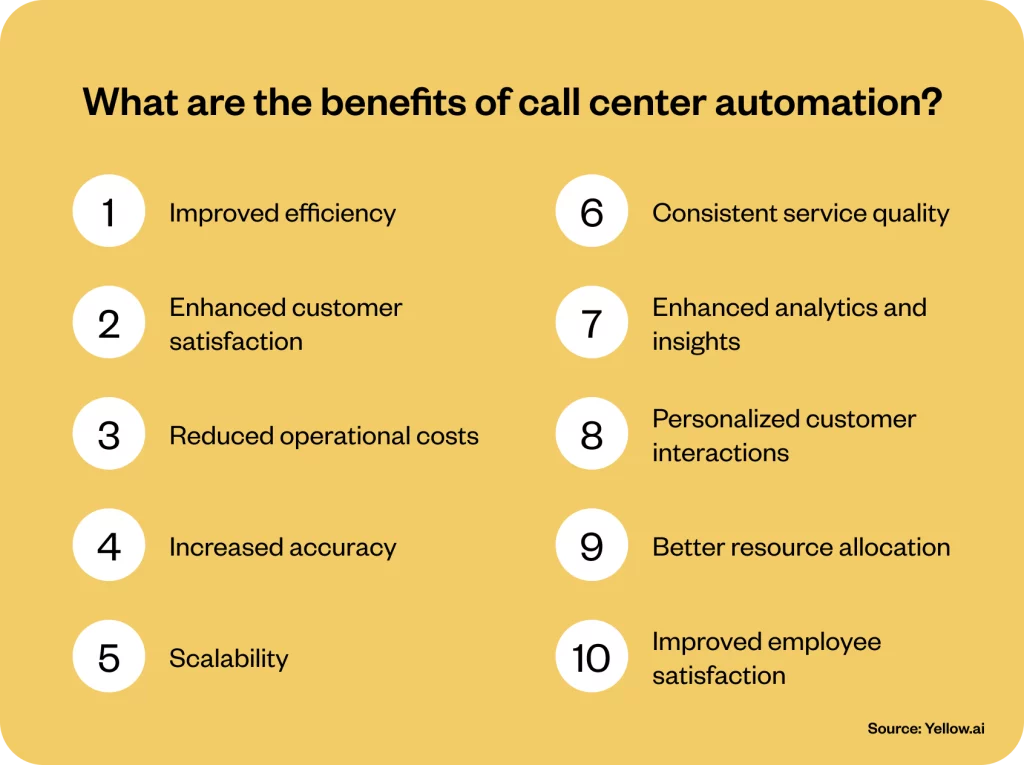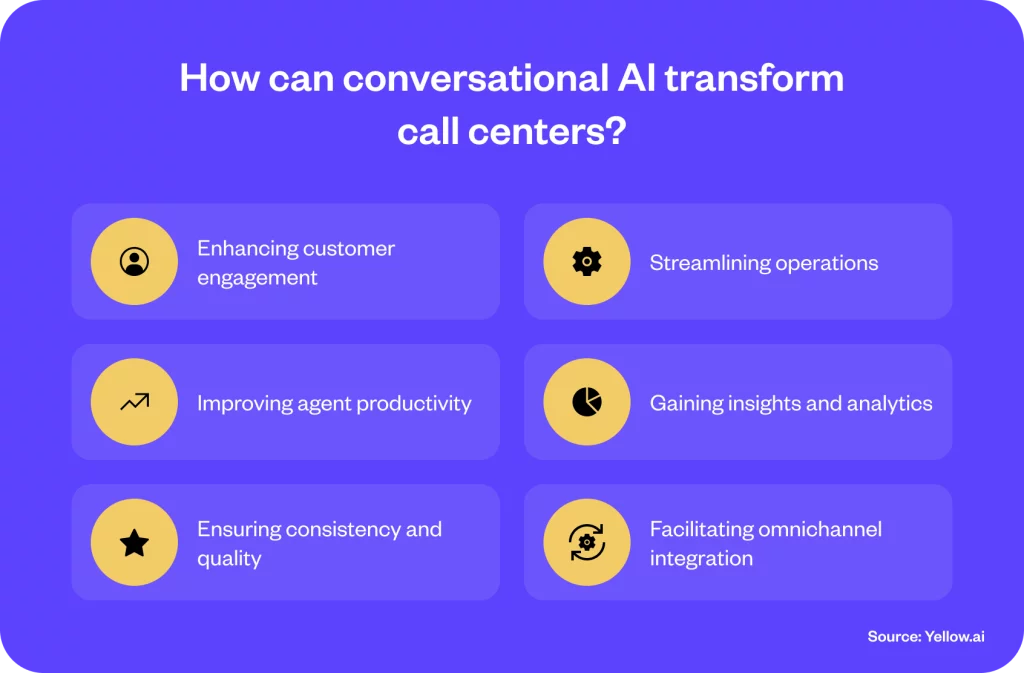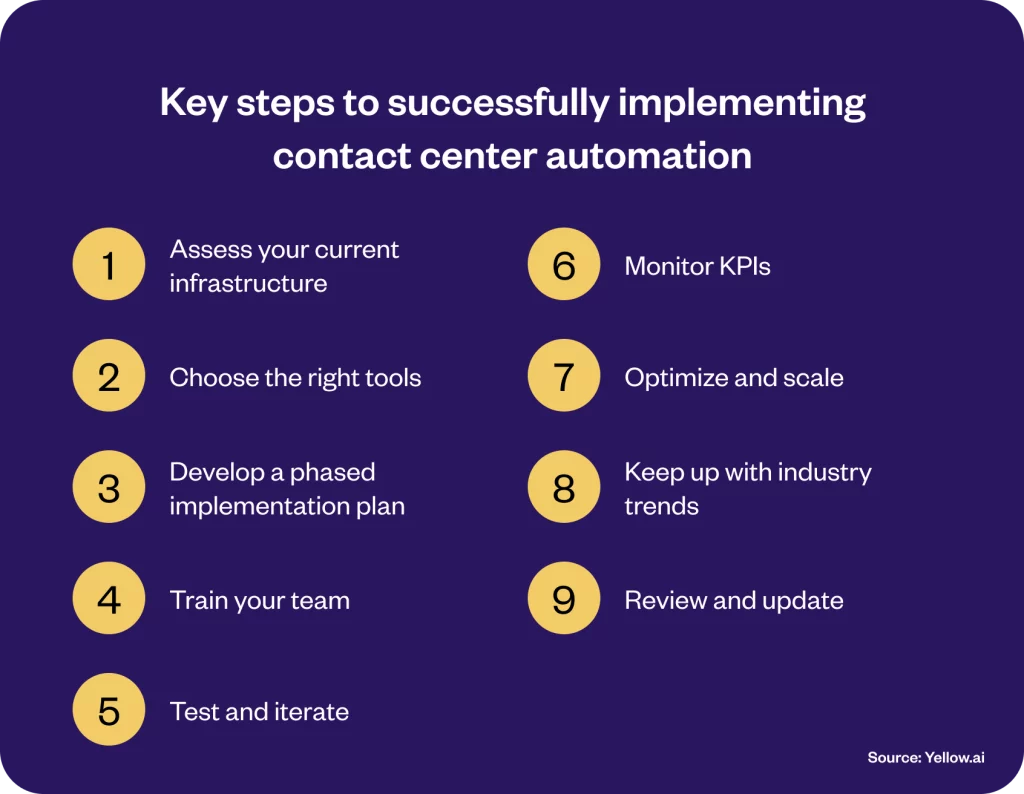Executive summary
Call center automation is emerging as a pivotal innovation in the arena of customer service. It is reshaping the landscape of customer interactions. This blog dives deep into the intricacies of call center automation, exploring its significance, trends, tools, and real-world applications. We highlight how automation refines operational efficiency and also significantly boosts customer satisfaction and cost-effectiveness. Through this insightful blog, we demonstrate how businesses can effectively integrate call center automation into their customer support strategy, setting the stage for enhanced performance and elevated customer experiences.
Picture a bustling call center, the nerve center of customer interactions, now seamlessly powered by the precision of automation. The shift from traditional call handling to automated systems is much more than just a technological leap. It is a strategic move towards redefining customer service excellence. In a world where 94% of customers claim that positive service experiences influence their repeat purchase decisions, yet only 13% find their issues resolved with minimal effort, automation is a necessity.
Imagine, for a moment, the potential of a system that addresses customer queries with lightning speed and does so with a personalized touch that was once the sole domain of human agents. We’re witnessing an era where technology does not replace human interaction but enriches it, where automated responses are tailored not just to answer but to understand, empathize, and connect. This blog navigates through this paradigm shift, presenting a compelling case for why mastering call center automation is an operational upgrade and a critical step toward staying relevant and competitive in the ever-evolving business landscape.
Related must-reads:
- Call center software – A Complete Guide [2024]
- Contact center automation: Revolutionize your customer service
- Cloud contact centers: Transforming customer service
- AI Agent Assist – Elevating customer support efficiency
What is call center automation?
Imagine a bustling hub of customer interaction, now revolutionized by the integration of cutting-edge technology. Call center automation represents this evolution, transforming how businesses engage with their customers. It’s about harnessing the power of technology like Artificial Intelligence (AI), Robotic Process Automation (RPA), and Natural Language Processing (NLP) to elevate the efficiency and effectiveness of customer service operations. This approach shifts the paradigm from conventional, labor-intensive processes to a more dynamic, responsive, and adaptable model.
Through call center automation, interactions are enriched, ensuring that every customer query is addressed with precision and a personal touch. The key lies in the seamless marriage of technology and human insight. AI-driven chatbots, sophisticated IVR systems, and intuitive voice bots become more than tools; they transform into partners that work in concert with human agents. This synergy between digital and human elements in customer service opens up new vistas for innovation, setting a new standard for customer engagement and satisfaction in the modern business landscape.
Call center automation is a transformative force in a fast-paced business environment. It redefines the very essence of customer service. Call center automation is the strategic incorporation of advanced technologies like Artificial Intelligence (AI), Robotic Process Automation (RPA), and Natural Language Processing (NLP) to streamline and enhance customer interactions within a call center setting. This innovation transcends the traditional manual efforts of human agents and paves the way for a more efficient, responsive, and adaptable customer service framework.
However, the true power of call center automation lies in its ability to integrate human and virtual agents. They create a synergistic relationship where each complements the other. While virtual agents manage routine interactions, they seamlessly escalate complex or sensitive issues to human agents. It ensures that every customer experience is handled with the utmost care and professionalism.
This collaborative ecosystem elevates the customer experience and also empowers human agents to focus on higher-value tasks and complex problem-solving. That enhances the overall productivity and effectiveness of the call center. Through this fusion of technology and human touch, call center automation becomes a critical tool for businesses seeking to thrive in the competitive landscape of customer service excellence.
Types of call center automation
The horizon of call center automation is vast and diverse. It encompasses a range of technologies, each designed to optimize different aspects of customer service operations. Let’s explore the various types of automation that are reshaping call centers.

1. Call scheduling automation
This type of automation streamlines the process of scheduling calls with customers, making it more efficient and effective. By leveraging data from customer relationship management (CRM) systems, call scheduling automation can proactively set up calls for contract renewals, upgrades, or other customer needs. Furthermore, advanced dialer systems like progressive and predictive dialers can increase the likelihood of successful connections by predicting when customers are most likely to answer, reducing the incidence of missed calls.
2. Customer interaction automation
customer interaction automation is a cornerstone of modern call centers. It includes technologies like AI chatbots and virtual assistants. These tools can autonomously handle routine customer inquiries and provide instant responses and guidance. Enhanced IVR and intelligent voice assistants take this a step further by identifying customer issues and directing them to the appropriate service channels. This automation enhances customer self-service capabilities and also streamlines the process of connecting customers with human agents for more complex issues.
3. Sales and marketing automation
Beyond customer service, call centers play a crucial role in driving sales and marketing initiatives. Automation in this area can significantly expedite the sales process and enhance marketing efforts. By integrating with CRM systems, these tools can deliver personalized marketing messages and sales prompts based on individual customer profiles and behaviors. This level of customization can lead to more effective customer engagement and higher conversion rates.
4. Forecasting automation
Forecasting automation is the key to workforce optimization. It helps predict call volumes across various channels and schedule staff accordingly. Advanced systems utilize machine learning to consider multiple factors, including agent availability and historical data, to create efficient schedules. It ensures that call centers are adequately staffed to handle customer inquiries, leading to reduced wait times and improved service levels.
5. Workflow operations automation
Workflow operations automation focuses on internal processes and reduces the repetitive tasks that agents and managers often face. From assigning agents to specific queues based on demand to ensuring compliance with service level agreements (SLAs), these tools help in managing day-to-day operations more efficiently. Besides improving operational effectiveness, it also allows agents to focus on more complex and rewarding tasks, enhancing job satisfaction.
6. Messaging automation
Messaging automation is often associated with marketing. However, it also plays a critical role in internal communications within call centers. These tools can automate the dissemination of critical alerts, reports, and updates across the organization. As a result, messaging automation ensures that all team members are on the same page. It enhances coordination and efficiency, contributing to a more cohesive and responsive call center environment.
What are the benefits of call center automation?
Call center automation offers various advantages, each contributing significantly to enhancing business operations and customer experiences. Let us explore these benefits.

1. Improved efficiency
Efficiency is the cornerstone of call center automation. By automating routine tasks and responses, businesses can handle customer inquiries more rapidly and accurately. For instance, AI-driven chatbots can instantly provide answers to common questions. It can reduce wait times and increase the overall throughput of the call center. The heightened efficiency streamlines operations and also allows human agents to focus on more complex, value-added tasks.
2. Enhanced customer satisfaction
One of the most tangible benefits of automation is the boost in customer satisfaction. Automated systems provide quick, consistent responses, ensuring customers receive timely and accurate assistance. For example, an automated ticketing system can instantly acknowledge customer inquiries and provide estimated response times. It sets clear expectations and reduces customer anxiety.
Related read: 8 Tips to improve customer satisfaction in 2024
3. Reduced operational costs
Automation significantly cuts down operational costs. By handling repetitive tasks and inquiries, automation reduces the need for a large workforce, thereby lowering labor costs. A study by Juniper Research found that chatbots could help businesses save more than $8 billion per year by 2022. This cost efficiency is a game-changer for businesses looking to optimize their budgets without compromising on service quality.
4. Increased accuracy
Manual processes are prone to errors, but automation minimizes this risk. Automated systems follow programmed protocols, ensuring high accuracy in tasks like data entry or transaction processing. For instance, automated billing systems reduce the likelihood of errors in customer invoices. As a result, it enhances trust and reduces the need for corrective actions.
5. Scalability
Automation enables call centers to scale their operations in response to fluctuating demand easily. During peak periods, automated systems can handle increased volumes of inquiries without the need to increase staff proportionally. This scalability is vital for businesses experiencing rapid growth or seasonal spikes in customer contact.
6. Consistent service quality
With automation, businesses can ensure a consistent level of service quality. Automated responses and processes are designed to provide uniformity in customer interactions, thereby maintaining a consistent brand voice and service level. This consistency is crucial in building and maintaining customer trust and loyalty.
7. Enhanced analytics and insights
Automated systems generate valuable data and insights, helping businesses understand customer behavior and preferences better. These analytics can inform strategic decisions and help in refining customer service approaches.
For example, data from automated systems can reveal common customer pain points, guiding improvements in products or services.
8. Personalized customer interactions
Despite being automated, these systems can deliver personalized experiences. By leveraging customer data, automated tools can tailor interactions based on individual customer profiles, enhancing engagement and satisfaction. A simple example is personalized product recommendations based on a customer’s purchase history.
9. Better resource allocation
Automation allows for more strategic resource allocation. With routine tasks automated, human agents can be deployed to areas where they add the most value, such as handling complex customer issues or engaging in proactive customer outreach.
10. Improved employee satisfaction
Finally, automation can lead to higher employee satisfaction. By removing repetitive and mundane tasks, employees can focus on more engaging and rewarding work. It can lead to increased job satisfaction, reduced turnover, and a more motivated workforce.
How can conversational AI transform call centers?
Conversational AI is revolutionizing the landscape of call centers. It is marking a significant shift from traditional communication methods to more dynamic, interactive, and customer-centric approaches. This transformation is about redefining the entire customer service experience. Here’s how conversational AI is making a significant impact:

Related read: How to get started with conversational AI?
1. Enhancing customer engagement
- Personalized interactions: Conversational AI, through its learning algorithms, can provide personalized interactions based on customer history and preferences. This personal touch can significantly elevate the customer experience, making each interaction feel unique and valued.
- 24/7 availability: One of the most significant advantages is the around-the-clock availability of service. AI-driven chatbots and virtual assistants can engage with customers at any time, ensuring that help is always at hand, irrespective of time zones or holidays.
2. Streamlining operations
- Efficient query resolution: Conversational AI can handle a multitude of routine queries quickly and efficiently, freeing up human agents to tackle more complex issues. It leads to faster resolution times and higher customer satisfaction.
- Reducing operational costs: By automating routine tasks, conversational AI can significantly reduce operational costs. It minimizes the need for a large workforce dedicated to handling basic inquiries, thereby optimizing resource allocation.
3. Improving agent productivity
- Supporting agents with AI: Conversational AI can act as a support system for human agents, providing them with instant access to customer data, past interactions, and potential solutions. This integration enhances the agent’s ability to resolve issues more effectively and efficiently.
- Training and development: AI can also play a crucial role in training and development. By analyzing vast amounts of interaction data, AI can identify best practices and areas for improvement, which can be used to train new and existing agents.
4. Gaining insights and analytics
- Data-driven strategies: The data generated through AI interactions provides valuable insights into customer behavior and preferences. Businesses can use this data to tailor services, improve product offerings, and develop targeted marketing strategies.
- Predictive analytics: Advanced AI systems can analyze patterns and trends, predicting customer needs and behaviors. Businesses can use this foresight to proactively address issues, personalize interactions, and enhance the overall customer journey.
5. Ensuring consistency and quality
- Standardized responses: AI ensures that the information provided to customers is consistent and accurate. Furthermore, it remains uniform every time the customer seeks similar information. This uniformity is crucial in maintaining trust and reliability in the brand.
- Quality control: With AI, quality control becomes more manageable. Consistent monitoring and analysis of interactions ensure that the quality of service remains high. It also guarantees that businesses can quickly address any deviations.
6. Facilitating omnichannel integration
- Seamless experience across channels: Conversational AI can integrate with various communication channels like email, chat, social media, and voice calls, providing a seamless experience for customers regardless of their chosen medium.
Incorporating conversational AI into call centers is more than just about keeping up with technological trends. It is about taking a proactive step toward enhancing customer relationships, operational efficiency, and overall business performance. With solutions like Yellow.ai, businesses can leverage the full potential of AI, transforming their call centers into dynamic, efficient, and customer-focused hubs. This shift towards AI-driven communication is an essential strategy for businesses aiming to thrive in today’s competitive market.
Key steps to successfully implementing call center automation
Successful implementation of call center automation requires a strategic approach. It should focus on the right tools, continuous training, testing, and iteration. By following the given steps, businesses can create an efficient, responsive, and customer-centric call center environment.

Here are vital steps to ensure the successful implementation of call center automation.
1. Assess your current infrastructure
Before implementing any automation, it’s vital to understand your existing setup. This assessment includes reviewing your technology, processes, and workforce capabilities. An in-depth review helps identify gaps and opportunities for automation.
Example: A retail company used an assessment to discover that their call center was spending excessive time on routine inquiries. By identifying this, they could focus their automation efforts on these areas, leading to a significant reduction in response times and improved agent productivity.
2. Choose the right tools
The selection of automation tools should align with your specific needs. Additionally, it should integrate seamlessly with your existing technology. It’s important to choose solutions that are scalable, reliable, and offer functionalities that match your requirements.
Example: A healthcare provider chose an AI chatbot solution that integrated with their existing CRM system. This integration allowed for seamless data sharing and personalized customer interactions, enhancing the overall customer experience.
3. Develop a phased implementation plan
Implementing automation should be a phased process. Start with automating simpler, high-volume tasks and gradually move to more complex areas. This approach allows for testing, learning, and adjusting strategies as necessary.
Example: A financial services firm started by automating their appointment scheduling and then gradually moved to automate more complex processes like loan application queries.
4. Train your team
Training your team on new automation tools is crucial. Ensure they understand how to use the technology and how it fits into the overall customer service strategy.
Example: An ecommerce company conducted comprehensive training sessions for their agents, focusing on how to work alongside AI tools. It led to a smoother transition and better acceptance of the new system.
5. Test and iterate
Before a full-scale rollout, pilot the automation tools in a controlled environment. Gather feedback and data to make necessary adjustments. This iterative process helps fine-tune the system for optimal performance.
Example: A telecom company ran a pilot program for their new IVR system, allowing them to identify and fix issues before launching it to all customers.
6. Monitor KPIs
Once implemented, continuously monitor key performance indicators (KPIs) like customer satisfaction, response time, and resolution rates. This monitoring helps gauge the effectiveness of the automation and identify areas for improvement.
Example: A logistics company used analytics tools to track the performance of their automated customer service system, leading to regular adjustments and improvements.
7. Optimize and scale
After successful implementation, consider expanding and optimizing your automation efforts based on performance data and changing business needs.
Example: A software company, after automating basic customer queries, expanded to automate their technical support using AI-based diagnostics tools.
8. Keep up with industry trends
The field of call center automation is continually evolving. Stay informed about the latest trends and technologies to keep your system up-to-date and competitive.
Example: A business services firm regularly attends industry webinars and incorporates the latest AI advancements into its call center.
9. Review and update
Regularly review and update your automation strategies to align with evolving business goals and customer expectations. This review should be an ongoing process to ensure continuous improvement.
Example: An insurance company conducts quarterly reviews of its automated systems, making adjustments to workflows and processes based on customer feedback and new technology developments.
How Yellow.ai can help you automate your call center
Yellow.ai, the beacon of innovation in the evolving landscape of customer service, offers state-of-the-art AI automation tools. Our AI automation tools revolutionize call centers. With a focus on seamless automation and enhanced customer experiences, Yellow.ai provides a suite of tools that cater to the dynamic needs of modern businesses.
Here’s how Yellow.ai can transform your call center:
- AI-driven chatbots: Yellow.ai’s sophisticated chatbots are equipped with advanced AI. They are capable of understanding and responding to customer queries in real-time, ensuring immediate and accurate support.
- Omnichannel support: With Yellow.ai, engage your customers across various platforms – be it social media, email, or voice calls – ensuring a consistent and integrated service experience.
- Personalization at scale: Utilize AI to offer personalized interactions based on customer data, enhancing customer satisfaction and loyalty.
- Efficient workflow management: Streamline operations by automating routine tasks, freeing your agents to focus on complex customer interactions.
- Data-driven insights: Leverage the power of AI to analyze customer interactions, providing valuable insights for strategic decision-making and service improvement.
- Scalability: Effortlessly handle fluctuating customer inquiries, thanks to Yellow.ai’s scalable solutions that grow with your business.
Ready to elevate your customer service experience?

The final thoughts
Technological advancements are a cornerstone in the future of customer service. Automation, especially when enhanced by AI and machine learning, is reshaping the very fabric of customer interactions, offering unparalleled efficiency and accuracy. The integration of such technology in call centers signifies a new era of customer service – one that is more responsive, personal, and efficient.
Businesses embracing this shift are staying ahead of the curve and redefining it. It ensures businesses remain competitive and relevant in an ever-changing market. As we continue to witness the evolution of customer service, one thing remains certain: the future is automated, and it is now.
Frequently asked questions (FAQs)
What is the future of call center automation?
The future of call center automation is intrinsically linked with advancements in AI and machine learning. Today’s businesses are moving towards more intuitive, predictive, and personalized customer service experiences. It is no secret that automation will continue to evolve. It will offer more sophisticated interactions and seamless integration across various customer touchpoints.
How does automation improve customer service in call centers?
The impact of automation on customer service within call centers is profound. Primarily, it streamlines processes and ensures that responses to customer inquiries are faster and remarkably consistent. It is free from errors that can occur in manual operations. Moreover, automation is equally adept at personalizing interactions. Tailoring responses and solutions based on individual customer data transforms a generic encounter into a more engaging and satisfying experience. Automation acts as a catalyst that elevates the standards of customer service in call centers.
What are the common automation tools used in call centers?
Common automation tools include AI-driven chatbots, interactive voice response (IVR) systems, automated ticketing systems, predictive dialers, and CRM integrations. These tools streamline various aspects of customer service. These aspects range from initial contact to query resolution.
How does AI and machine learning contribute to call center automation?
AI and machine learning are pivotal in analyzing customer data, predicting behavior, and personalizing interactions. They enable chatbots and virtual assistants to learn from interactions, thereby improving their ability to handle complex queries and offer relevant solutions.
Can automation in call centers reduce the need for human agents?
While automation handles routine tasks efficiently, the need for human agents remains crucial for complex and sensitive issues. Automation complements human agents by freeing them from repetitive tasks, allowing them to focus on areas where human empathy and problem-solving are essential.
How can businesses measure the success of call center automation?
Success can be measured by analyzing key performance indicators such as customer satisfaction scores, resolution times, cost savings, and accuracy of responses. Regular monitoring and customer feedback are essential in assessing the effectiveness of automated systems.






















